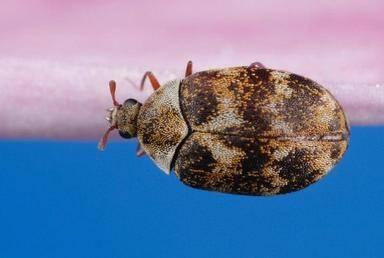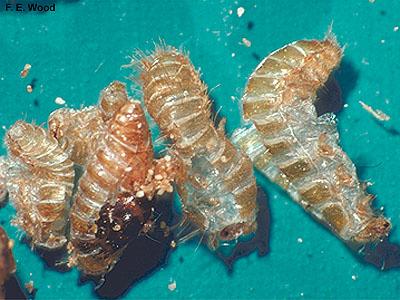About carpet beetles
-
Carpet beetles are common pests of fabrics.
-
Adult carpet beetles do not damage fabrics. They feed outdoors on pollen or not at all.
-
It is the larva or immature stage of these insects that cause damage to fabrics, fur, feathers or virtually anything made of animal fibers.
-
The adults fly and some are attracted to lights and windows, making them more conspicuous in homes than the larvae.
-
The adult female beetles lay eggs in woolen goods, cracks, and other concealed places.
Adult carpet beetles
-
There are several different types of carpet beetles that may be found in homes, but the two most common are the varied carpet beetle and the black carpet beetle.
-
The varied carpet beetle adult is small (2-3 mm), oval to round, with splotches of white and yellow, appearing to have a gray calico pattern. The larva is tear-drop shaped and is covered with rows of light brown hairs. The varied carpet beetle larva is primarily a scavenger. It often goes unnoticed behind furniture or along baseboards where it feeds on such things as accumulated lint, pet hair, food crumbs, dead insects and other organic debris.
-
The black carpet beetle adult is larger, a solid dark brown or dull black color, and shaped more like a long oval than the varied carpet beetle (photo at top of page).
-
Immature carpet beetles larvae feed on dried animal products like wool, felt, hair, fur, feathers, dead animals, stuffed trophy heads, etc.
-
They do not feed on clean synthetic or man-made fabrics but they can be found feeding in wool-synthetic blends or on synthetic fabrics stained with urine or sweat.

Varied carpet beetle (Anthrenus verbasci). Photo: Joseph Berger, Bugwood.org

Varied carpet beetle larva. Photo: Joseph Berger, Bugwood.org
Carpet beetle larvae
-
The varied carpet beetle larva is tear-drop shaped and is covered with rows of light brown hairs. It is primarily a scavenger. It often goes unnoticed behind furniture or along baseboards where it feeds on such things as accumulated lint, pet hair, food crumbs, dead insects, and other organic debris.
-
The black carpet beetle larva is 3-7 mm long and carrot-shaped. It is covered with golden brown hairs and has a characteristic "tail" of long hairs at the rear end.
-
Carpet beetle larvae are repelled by light and tend to burrow deep into wool, upholstery, or other materials to feed.
-
Carpet beetle larvae can crawl from place to place but are usually found in concealed locations along baseboards, under large pieces of furniture, or in little used drawers or storage areas. These larvae are oval to cigar shaped and densely covered with yellow-orange or light brown hairs.
-
To grow they molt or shed their skins. In heavy infestations, these light colored shed skins may be seen in the infested material.

Shed skins of carpet beetle larvae
Management
-
Sanitation is very important. Thorough vacuuming of carpeting, along baseboards, under furniture, and in closets is recommended. Dispose of vacuum cleaner bag outdoors.
-
Pay particular attention to woolens. Make sure to properly clean wool clothing before storage. Soiled wool is particularly attractive to carpet beetles.
Rev. 2020
